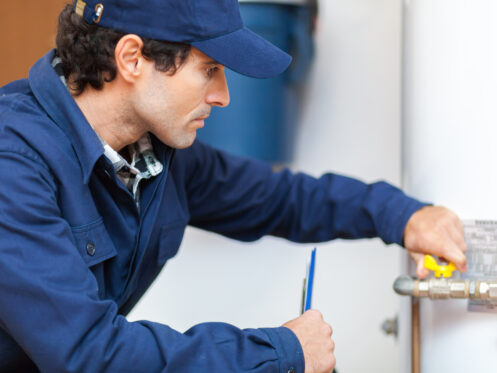Water heaters are essential devices in our homes, providing us with the comfort of hot water for showers, cleaning, and cooking. Sometimes, your water heater might not produce hot water, which is frustrating. A functioning water heater is important for keeping a comfortable home, especially during colder months.
This article will help you understand how water heaters work, finding common issues that cause a lack of hot water, and giving tips to fix problems. We will also give advice on keeping your water heater working well to help you avoid future problems.
Understanding How Water Heaters Work
To fix a water heater that is not making hot water, it’s good to know how these devices operate. Water heaters usually use electricity or gas to heat water stored in a tank or on-demand in a tankless system.
- Electric Water Heaters: These use parts inside the tank to warm the water. The thermostat controls the temperature and keeps it at the right level.
- Gas Water Heaters: These use a burner at the bottom of the tank. The gas is lit by a small flame or electronic starter.
- Tankless Water Heaters: These heat water directly as it flows through the unit, giving hot water when needed without keeping it in a tank.
For a more detailed explanation of how water heaters function, you can visit How Does a Water Heater Work | Water Heater Guide 2019.
Common Causes for Water Heater No Hot Water
Not having hot water can be annoying, especially when you depend on hot water every day. Here are some usual reasons your water heater might not make hot water:
- Faulty Thermostat: A malfunctioning thermostat can prevent your water heater from reaching the desired temperature. Check the thermostat settings and ensure they are properly adjusted.
- Broken Heating Elements: For electric water heaters, heating elements can burn out over time. If one or both elements fail, your water heater may not produce hot water. You may need to replace the faulty elements.
- Pilot Light Issues: In gas water heaters, the pilot light might go out, stopping the heater from igniting the gas. Ensure the pilot light is lit; if not, follow the manufacturer’s instructions to relight it.
By understanding these common issues, you can take the first steps in troubleshooting your water heater problems.
Initial Checks for No Hot Water in House
When faced with hot water not working, start with these initial checks to diagnose the issue:
- Check the Power Supply: Ensure your water heater is receiving power. For electric heaters, verify that the unit is plugged in and that the circuit breaker has not tripped.
- Inspect Circuit Breakers: Sometimes, a tripped breaker can cut off power to your water heater. Reset the breaker if necessary.
- Examine the Pilot Light: For gas heaters, make sure the pilot light is on. If it’s out, follow the manufacturer’s guide to safely relight it.
Different types of water heaters may require specific troubleshooting steps:
- Electric Water Heaters: Check for blown fuses or tripped breakers and inspect the thermostat settings.
- Gas Water Heaters: Verify that the gas supply is on and the pilot light is lit.
- Tankless Water Heaters: Ensure the flow rate is sufficient and there are no blockages in the system.
Regular maintenance is crucial in preventing these issues. For more on the importance of upkeep, visit The Importance Of Water Heater Maintenance or check out our Water Heater Maintenance Guide.
Tankless Water Heater No Hot Water: Special Considerations
Tankless water heaters have become a popular choice for many homeowners due to their energy efficiency and compact size. However, they can present unique challenges when it comes to providing hot water. Here are some special considerations to keep in mind:
- Flow Rate Issues: Tankless water heaters require a minimum flow rate to activate the heating elements. If the flow rate is too low, the unit may not turn on. Check your water fixtures to ensure they provide enough flow.
- Improper Installation: Incorrect installation can lead to performance issues. Make sure your tankless water heater is installed according to the manufacturer’s specifications.
- Cold Weather: In colder climates, the incoming water temperature can be significantly lower, which may affect the heater’s ability to provide hot water quickly. Insulating pipes can help mitigate this issue.
- Regular Maintenance: Like all water heaters, tankless models require regular maintenance to function optimally. This includes descaling the unit to prevent mineral buildup.
Understanding these specific issues can help you troubleshoot and maintain your tankless water heater effectively.
Ensuring Reliable Hot Water with Quality Cooling and Heating
Having a reliable source of hot water is essential for a comfortable home. In this article, we’ve explored various troubleshooting tips and maintenance advice to help you address issues when your water heater isn’t providing hot water. By understanding how water heaters work and identifying common problems, you can take proactive steps to ensure your heater functions smoothly.
If you’re facing persistent problems or need professional help, consider reaching out to Quality Cooling and Heating. Our team offers expert HVAC and plumbing services tailored to meet the needs of homeowners in the Greater Austin area and Abilene. With our commitment to quality and customer satisfaction, we can help you maintain a comfortable living environment.
Whether it’s a simple fix or a more complex issue, Quality Cooling and Heating is here to provide the reliable solutions you need. Contact us today to schedule a service or to learn more about how we can assist with your water heater maintenance and repair needs. For more information on replacement costs, visit our Water Heater Replacement Cost Tips page. If you’re in the Abilene area, our Plumbing Company in Abilene, TX is ready to help.


